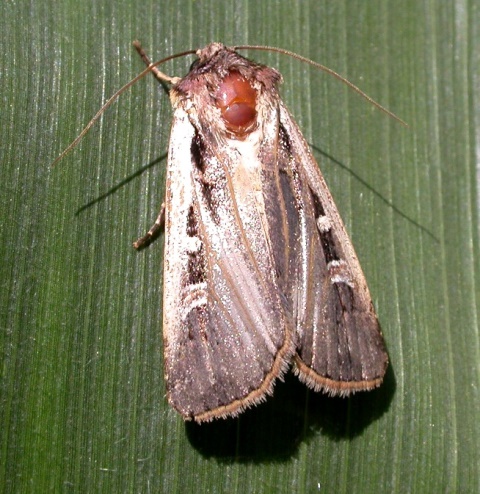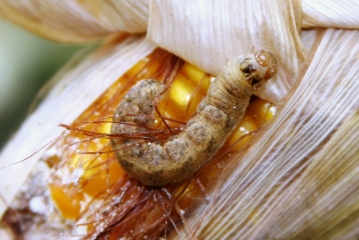
- The western bean cutworm is a late-season pest of corn that robs yield and reduces grain quality.
- Many 'above-ground' Bt traits will not control western bean cutworm.
- Threshold is 5% of corn plants with egg masses and/or early instar larvae feeding in leaf axils.
- The goal of chemical management is to ensure that hatched larvae are contacted by insecticide and eliminated prior to entering the ear to feed.
- Insecticides should be applied at 90-95% tassel emergence and 70-90% egg hatch.
Identification and Biology
The western bean cutworm (Striacosta albicosta Smith) is a late-season pest of corn that reduces yield and predisposes the ear to fungal rots, which reduce grain quality. Adult moths are gray-brown in color with a creamy white stripe down the length of the forewing, and a small cream-outlined circle and kidney bean shape behind the stripe on each forewing (Image 1).
Western bean cutworm has one generation per year with adult moths emerging over a period of weeks in July. Females mate and lay eggs during late July and August in late vegetative corn on the upper surface of leaves that remain mostly unfurled in the whorl and in a vertical orientation near the top of the corn canopy. Egg masses average around 50 eggs in size and are white when first laid, then progress to a dark purple coloration nearing hatch (Image 2).
Fourth instar and large larvae range in size from 0.5-1.5 inches long, are light tan in color, with subtle stripes, an orange head, and smooth skin. The identifying characteristic is two dark rectangles behind the head (Image 3). Sixth instar larvae drop to the ground in the fall, burrow into the soil, and form a pre-pupal case.
Plant Injury
Hatching larvae consume their eggshells, removing evidence of the egg masses after hatch. Larvae then move into leaf axils and feed on fallen anthers, pollen, and leaf tissue. More mature larvae migrate to the ear and enter the ear to feed on the developing grain. Entry holes are not easily visible, so scouts need to peel back shucks to inspect for larvae in the ear. The point of entry to the ear increases risk for development of ear rots and has potential to reduce grain quality.
Scouting and Thresholds
Pheromone traps can be used to monitor adult moth activity from late June to late July. At peak moth flight, begin scouting for eggs by inspecting the upper surfaces of whorl leaves on several plants within a field. Check leaf axils for newly emerged larvae. Egg-laying occurs over a period of several weeks, which means that frequent scouting will be required. Distribution within a field is often patchy. Multiple larvae may infest a single plant and larvae may disperse from the plant where they hatched to surrounding plants. Threshold is reached when 5-8% of plants have egg masses or young larvae.
Management
Most above-ground Bt traits are not effective against western bean cutworm. Broad lepidopteran Bt traits, such as Vip3A, may provide adequate control. Please see reference 'The Handy Bt Trait Table' to see which trait platforms provide control. With most hybrids, scout and apply insecticides when levels reach threshold.
Egg hatch often coincides with tassel emergence. The management objective is to ensure that young larvae are contacted by insecticide and killed prior to entering the ear to feed. Apply foliar insecticide when 90-95% of corn has tasseled and when 70-90% of eggs have hatched. A number of insecticides are labeled for control. Permethrin and chlorantriniliprole have been shown to be particularly effective, especially when used in combination products or tank mixes with pyrethroids. Always read and follow label directions.
Contact your FS Crop Specialist for your agronomic information.
References:
The Handy Bt Trait Table (Michigan State University)
Western Bean Cutworm (Purdue University)


Image 1: Adult Western Bean Cutworm moth (GROWMARK, Inc.)
Image 2: Western Bean Cutworm egg mass on corn leaf (2017, FS Partners)
Image 3: Mature larvae feeding on the ear (GROWMARK, Inc.)